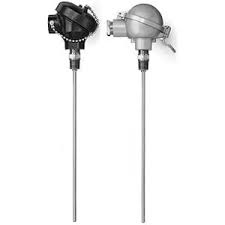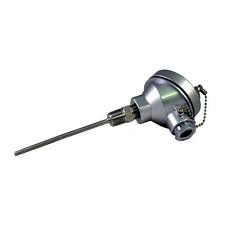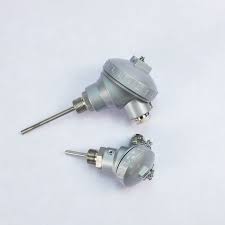Thermocouple Sensor





Thermocouple Sensor
Thermocouples are widely used temperature sensors that convert temperature variations into electrical voltage. They operate based on the Seebeck Effect, where two dissimilar metals, forming a closed circuit, generate an electromotive force (e.m.f.) when maintained at different temperatures.
Working Principle:
- Seebeck Effect:
- When two dissimilar metals form a closed circuit at different temperatures, an e.m.f. is induced.
- Transducer Function:
- Thermocouples act as transducers by converting temperature (non-electrical) into voltage (electrical), making them active transducers.
- No External Power:
- They don’t require an external power source for operation.
Working of Thermocouple:
- Circuit Setup:
- Two dissimilar metals (A and B) are joined at two junctions (P and Q).
- P is the measuring junction (hot), and Q is the reference junction (cold).
- Temperature Difference:
- When P and Q are at different temperatures, an e.m.f. is generated.
- Measurement:
- The e.m.f. is measured using a PMMC instrument, calibrated directly in terms of temperature.
- No Temperature Difference:
- When P and Q are at the same temperature, no e.m.f. is generated, and no current flows.
Reference Junction:
- Cold Junction:
- Normally connected to the measuring instrument and held at 0°C.
- Automatic reference compensation is often used for accuracy.
Specifications:
- Temperature Range:
- 0 to 1800 °C.
- Display:
- 3½ digit / 4 digit 7 Segment Red LED’s.
- Power Supply:
- 230/110 VAC or 24 VDC.
- Accuracy:
- ± 0.2% of the specific range.
- Resolution:
- 0.1/1 °C, subject to specific input and range.
- Input Sensors:
- Thermocouple types J, K, RTD Pt-100, 2 wire, 3 wire.
- Number of Set Points:
- Two (Configurable for High & Low).
- Control Output:
- 2 relay contacts NO/C/NC, rating 5 A @ 230 Vac.
Types of Thermocouples:
- T – Type:
- Positive wire: Cu, Negative wire: Constantan.
- Up to 350°C, stable and inexpensive.
- E – Type:
- Positive wire: Chromel, Negative wire: Constantan.
- Up to 850°C, highly sensitive and generates high output voltage.
- J – Type:
- Positive wire: Iron, Negative wire: Constantan.
- Up to 1000°C, common type with high stability.
- K — Type:
- Positive wire: Chromel, Negative wire: Alumel.
- Up to 1200°C, widely used and cost-effective.
- S – Type:
- Positive wire: Pt 10% Rhodium, Negative wire: Pt.
- Up to 1400°C, high precision for accurate requirements.
Advantages:
- Follow temperature changes with a small time-lag.
- Convenient for measuring temperature at specific points.
Disadvantages:
- Low accuracy, not suitable for high precision.
- Prone to contamination, requiring protection.
- Placed at a large distance from the measuring device, introducing errors.